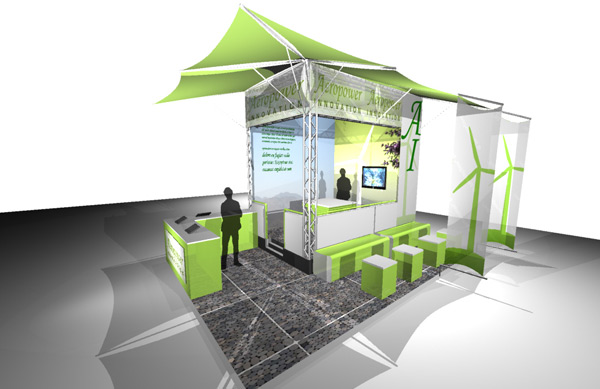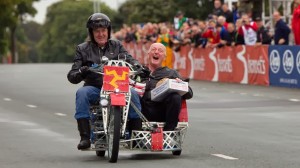Watching exhibition ideas develop into drawings, models and fly-throughs is very exciting – but how can one tell if the designs are any good? The only way to know for sure is to watch the design working on-site. As a result of doing just this over several years, we have consolidated five general principles that help guide our design thinking.
1. Create a good first impression
Making a big impact is always top of any design brief. Attract visitors by applying creative and bold ideas to the design: use the airspace above the stand as a visual signal; use new or different materials; incorporate unique props, exhibits and displays; think about interactive games and high technology solutions. Make people an important part of the design – exhibitions are not just an expose for 3D design, they are live events – use the buzz and drama of dressing-up, performing, compering or presenting to attract a crowd and create a good impression. Merchandising or giveaways should be well considered – create bespoke themed giveaways if possible, but otherwise make sure they are useful. Get the balance of these elements right and the design will have a head start in winning visitor’s approval and interest.
2. Create the right environment
In most cases the design must reflect the brand of the exhibitor. Use the structure, architecture, layout, displays, audio visual and lighting to create a visual and atmospheric embodiment of the brand. Creating a brand environment requires a good understanding of the company, the competition, the market and the target audience, and should not be confused with simply applying branding to an environment. The environment is also a function of the fundamental purpose of the stand. This must be obvious in the design – is the stand like market stall, a retail store, a hi-tech showcase, a theatre or a meeting place? Make the visit to the stand stress-free, use soft lighting, reassuring canopies, tiered levels and accessible seating. Design details can make or break a good design. Consider carefully all the materials, finishes, furniture, accessories and planting – from the canopy to the floor – every square inch is important. Building a great brand environment will enhance the quality of your audience’s experience.
3. Control movement
Exhibition design theory espouses the use of ‘zones’ to control traffic, but mostly all that is required is common sense. Think about the visitors as they come onto the stand – are they given to their own devices to browse and wander or are they directed to certain features or put on a journey or path; are they individually greeted and registered or invited for a meeting and asked to sit and wait or enjoy refreshments. Each specific need will require a space and area which must also allow for general movement and health and safety considerations. Most designs use a hierarchy of spaces to manage visitors – this might be expressed through a range of separate levels, tiers, or selective rooms. Design the stand to ensure people can move on and off, in and around with a clear sense of direction and purpose with intuitive ease.
4. Control messaging
In an exhibition, less information is always better than more. Tiered levels of messaging will help. Ensure the whole stand is guided by a distinctive top line theme. Then build layers of sub-messages using a range of concise stories or examples to illustrate and demonstrate the theme. Provide an online link for any further detailed information – or put it into printed material, a downloadable app, or giveaway flash drive. Video is great but in most cases, it needs to work without sound. Use short text instead of a audio script and put emphasis on the quality of visuals. Use screen information in tight looping packets so that a range of messages can be delivered over a period of time. Every event will feature the latest technology – but don’t let the technology override the communications: make any high tech, virtual, interactive or immersive solutions entertaining and informative but also concise. By carefully structuring the information conveyed within an exhibition you will give your visitors best chance of remembering your messages.
5. Think of the staff
Our first major exhibition design was based around a large central structure forming the core of the stand. Perfect in every respect, except the staff felt they were isolated from visitors on the other side of the stand! We now design stands that allow the entire stand to be monitored from any position. The staff experience can be as important as the visitor experience – whatever the nature of the stand. Essential considerations will be providing ample storage, refreshments, power, connectivity and an unobtrusive work and rest space. As a designer one should imagine the experience of manning a stand during the very long days of an exhibition event. Is the floor too hard, lighting too intense, sound irritating? In our experience, evaluation feedback will often prioritise the experience of the staff rather than effective communications to the audience. Happy and comfortable staff will be more effective ambassadors and therefore contribute to the success of the exhibition design.
These principles can be seen in our exhibition design work here.
And also have informed the design of our pavilion here.



